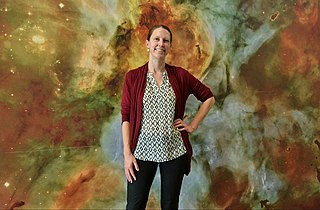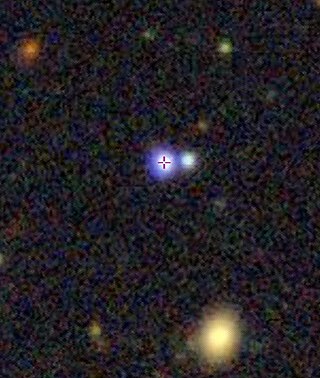Related Research Articles
The Newton Lacy Pierce Prize in Astronomy is awarded annually by the American Astronomical Society to a young astronomer for outstanding achievement in observational astronomical research. The prize is named after Newton Lacy Pierce, an American astronomer.

John Norris Bahcall was an American astrophysicist and the Richard Black Professor for Astrophysics at the Institute for Advanced Study. He was known for a wide range of contributions to solar, galactic and extragalactic astrophysics, including the solar neutrino problem, the development of the Hubble Space Telescope and for his leadership and development of the Institute for Advanced Study in Princeton.

The Giant Metrewave Radio Telescope (GMRT), located near Narayangaon, Pune in India, is an array of thirty fully steerable parabolic radio telescopes of 45 metre diameter, observing at metre wavelengths. It is the largest and most sensitive radio telescope array in the world at low frequencies. It is operated by the National Centre for Radio Astrophysics (NCRA), a part of the Tata Institute of Fundamental Research, Mumbai. It was conceived and built under the direction of Govind Swarup during 1984 to 1996. It is an interferometric array with baselines of up to 25 kilometres (16 mi). It was recently upgraded with new receivers, after which it is also known as the upgraded Giant Metrewave Radio Telescope (uGMRT).
Amy J. Barger is an American astronomer and Henrietta Leavitt Professor of Astronomy at the University of Wisconsin–Madison. She is considered a pioneer in combining data from multiple telescopes to monitor multiple wavelengths and in discovering distant galaxies and supermassive black holes, which are outside of the visible spectrum. Barger is an active member of the International Astronomical Union.

William Nielsen Brandt is the Verne M. Willaman Professor of Astronomy & Astrophysics and a professor of physics at the Pennsylvania State University. He is best known for his work on active galaxies, cosmological X-ray surveys, starburst galaxies, normal galaxies, and X-ray binaries.
Guinevere Alice Mei-Ing Kauffmann was born in California. She is an astrophysicist and is known for her work studying galaxies among other subjects.

Neta Bahcall is an Israeli astrophysicist and cosmologist specializing in dark matter, the structure of the universe, quasars, and the formation of galaxies.

Heather A. Knutson is an astrophysicist and professor of planetary science at California Institute of Technology in the Division of Geological and Planetary Sciences. Her research is focused on the study of exoplanets, their composition and formation.
Kristen Sellgren is an American retired astronomer and Professor Emerita at the College of Natural and Mathematical Sciences, Ohio State University. She won the Newton Lacy Pierce Prize in Astronomy in 1990. She is the founder of American Astronomical Society's Committee for Sexual-Orientation & Gender Minorities in Astronomy (SGMA).
Alan R. Duffy is a British and Australian professional astronomer and science communicator. He was born in England, raised in Northern Ireland, and is currently based in Australia. He is a professor at the Centre for Astrophysics and Supercomputing at Swinburne University of Technology, and is the Lead Scientist at the Royal Institution of Australia.
Benedetta Ciardi is an Italian astrophysicist.

Katherine Mary Blundell is a Professor of Astrophysics at the University of Oxford and a supernumerary research fellow at St John's College, Oxford. Previously, she held a Royal Society University Research Fellowship, and fellowships from the Royal Commission for the Exhibition of 1851 and Balliol College, Oxford.
Blakesley Burkhart is an astrophysicist. She is the winner of the 2017 Robert J. Trumpler Award awarded by the Astronomical Society of the Pacific, which recognizes a Ph.D. thesis that is "particularly significant to astronomy." She also is the winner of the 2019 Annie Jump Cannon Award in Astronomy and the 2022 winner of The American Physical Society's Maria Goeppert-Mayer Award. The awards both cited her work on magnetohydrodynamic turbulence, and for developing innovative techniques for comparing observable astronomical phenomena with theoretical models.
Katherine Gudrun Isaak is a British astrophysicist and the Project Scientist for the European Space Agency Characterising Exoplanet Satellite mission (CHEOPS). She is based at European Space Research and Technology Centre.

The Teacup galaxy, also known as the Teacup AGN or SDSS J1430+1339 is a low redshift type 2 quasar, showing an extended loop of ionized gas resembling a handle of a teacup, which was discovered by volunteers of the Galaxy Zoo project and labeled as a Voorwerpje.

Fabio Pacucci is an Italian theoretical astrophysicist and science educator, currently at Harvard University and at the Smithsonian Astrophysical Observatory. He is widely known for his contributions to the study of black holes, in particular the first population of black holes formed in the Universe and high redshift quasars. He discovered the only two candidate direct collapse black holes known so far, and he was in the team that discovered the farthest lensed quasar known. Pacucci is also a science educator, engaged in public talks on astronomy and science in general. Since 2018 he is a collaborator of TED in developing educational videos about science. The four videos released so far were watched by millions of people worldwide and translated into 25 languages.

Rosemary Theresa Coogan is an astrophysicist and UK astronaut from Northern Ireland. Her research considers galaxy evolution and space-based telescopes. She is part of ESA's European Astronaut Corps.

PKS 1402-012, also known as UM 632, is a quasar located in the constellation of Virgo. With a redshift of 2.51, the object is located 10.7 billion light-years from Earth.

4C +03.10 also known as PKS 0505+03 and OG +008, is a quasar located in the constellation of Orion. At a redshift of 2.46, the object is located 10.6 billion light-years away from Earth.
References
- 1 2 3 "Nadia Zakamska | Physics & Astronomy". physics-astronomy.jhu.edu. 8 February 2013. Retrieved 2016-06-21.
- 1 2 3 "Nadia Zakamska". Institute for Advanced Study. Retrieved 2016-06-21.
- 1 2 "Newton Lacy Pierce Prize in Astronomy | American Astronomical Society". aas.org. Retrieved 2016-06-21.
- ↑ "Q&A with Nadia Zakamska". IAS Ideas. Institute for Advanced Study. 16 September 2021. Retrieved 25 March 2022.
- ↑ "NASA Spitzer Fellowship" . Retrieved 27 October 2019.
- ↑ "John Bahcall Fellowship" . Retrieved 27 October 2019.